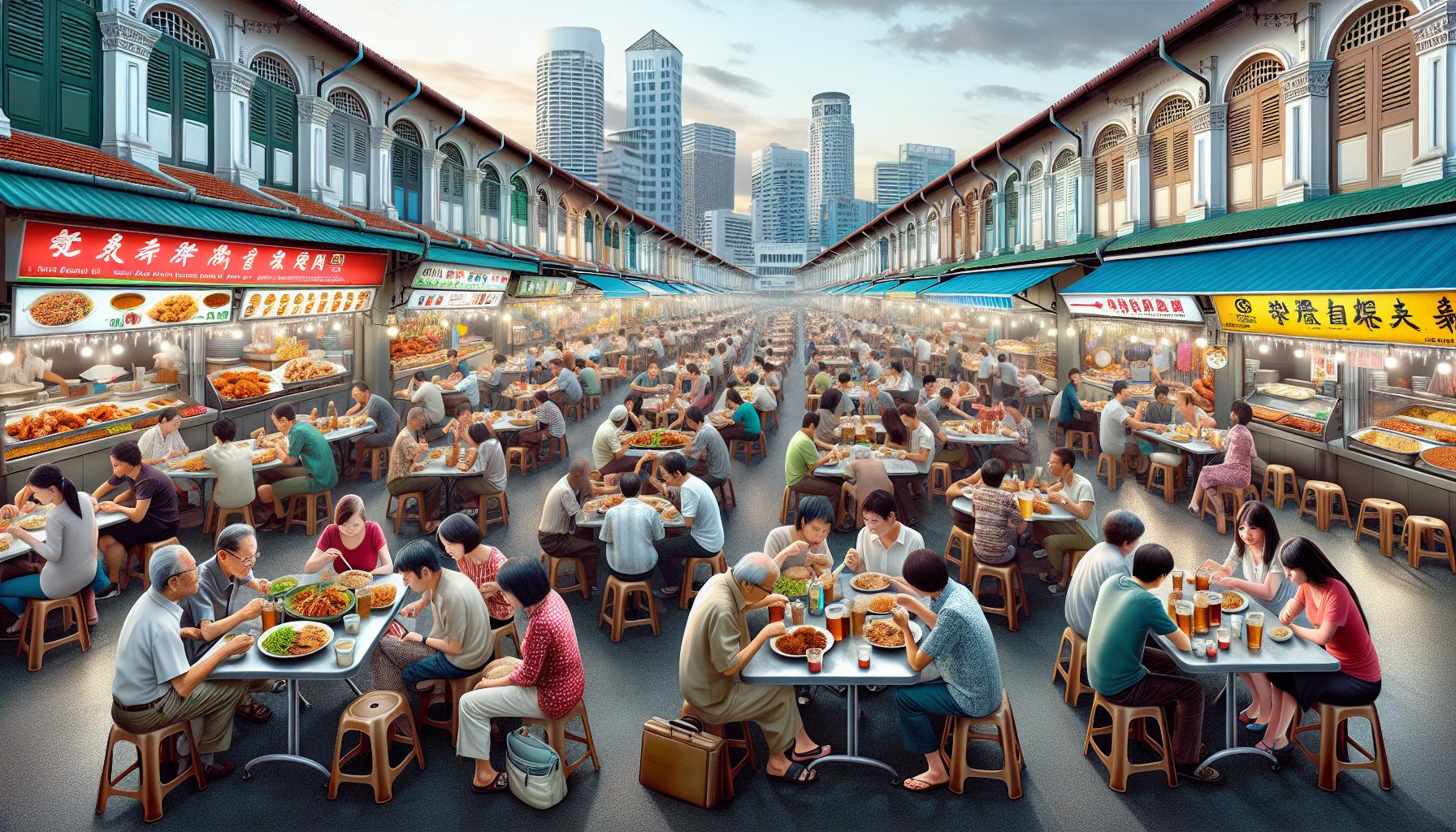Singapore food culture stands as a vibrant testament to its multicultural heritage where Chinese Malay and Indian flavors collide in an explosion of tastes. From bustling hawker centers to Michelin-starred restaurants this tiny island nation has earned its reputation as Asia’s ultimate food paradise.
The city-state’s obsession with food runs deep through its veins with locals often greeting each other with “Have you eaten?” instead of “Hello.” It’s a place where dining out isn’t just a necessity – it’s a national pastime. Whether it’s slurping up a steaming bowl of laksa at midnight or queuing for hours to taste the perfect chicken rice Singaporeans take their food seriously – really seriously.
Singapore Food Culture
Singapore food culture traces back to early trading settlements in the 14th century. The transformation from fishing village to global food destination spans centuries of cultural fusion.
Colonial Influences on Local Cuisine
British colonial rule shaped Singapore’s food landscape from 1819 to 1963. The British East India Company brought European cooking methods while attracting immigrants from China, India, and the Malay Archipelago. Chinese laborers introduced wok cooking techniques, creating dishes like Hainanese chicken rice – an adaptation of Hainan’s Wenchang chicken. Indian migrants contributed curry spices and flatbreads, leading to unique creations like roti prata. European influences manifested in dishes like beef rendang, which incorporated Portuguese cooking methods with local spices.
The Birth of Hawker Culture
Street food vendors emerged in Singapore during the 1800s, serving affordable meals to workers. The government relocated these vendors into organized hawker centers during the 1970s, establishing food hygiene standards. These centers became community hubs where vendors specialized in specific dishes, perfecting recipes across generations. Notable centers like Maxwell Food Centre and Lau Pa Sat preserve traditional cooking methods while offering diverse regional specialties. Singapore’s hawker culture earned UNESCO Intangible Cultural Heritage status in 2020, recognizing its significance in preserving culinary traditions.
Essential Dishes That Define Singapore Food

Singapore food culture emerges through iconic dishes that blend traditional cooking methods with diverse cultural influences. These signature creations showcase the distinctive flavors that make Singapore’s food scene internationally renowned.
Signature Seafood Creations
Chili crab stands as Singapore’s national seafood dish, featuring fresh mud crabs in a sweet-spicy tomato sauce. Black pepper crab delivers intense heat through crushed peppercorns paired with butter garlic sauce. Sambal stingray combines grilled skate with spicy sambal paste wrapped in banana leaves. Cereal prawns showcase fresh tiger prawns coated in crispy butter cereal flakes with curry leaves. Fish head curry merges Chinese cooking techniques with Indian spices, using red snapper in a rich coconut curry gravy.
Street Food Favorites
Laksa combines rice noodles in spicy coconut broth with prawns cockles bean sprouts. Hokkien mee features yellow egg noodles rice noodles stir-fried in prawn stock with seafood. Satay presents grilled meat skewers served with peanut sauce cucumber rice cake. Char kway teow delivers flat rice noodles wok-fried with Chinese sausage cockles bean sprouts in dark soy sauce. Roti prata offers crispy flatbread served with curry sauce or sugar. Carrot cake consists of radish cake stir-fried with eggs preserved radish chili sauce.
The Hawker Center Experience

Hawker centers form the backbone of Singapore’s dining culture, offering authentic local cuisine at affordable prices. These open-air food courts serve as communal spaces where people gather to enjoy diverse dishes in a vibrant atmosphere.
Traditional Food Courts vs Modern Food Halls
Traditional hawker centers showcase basic amenities with communal seating, ceiling fans and metal or plastic dishware. These centers maintain strict cleanliness standards through a standardized grading system displayed at each stall. Food prices range from $3-8 SGD per dish making them accessible to all income levels.
Modern food halls feature air conditioning, upscale furniture and aesthetic interior design elements. These establishments charge 30-50% higher prices than traditional centers, typically $8-15 SGD per dish. While offering similar local dishes, they incorporate contemporary cooking techniques and premium ingredients to attract younger demographics.
Notable Hawker Centers Worth Visiting
Maxwell Food Centre houses 100+ stalls specializing in Hainanese chicken rice, oyster cakes and fish soup. Old Airport Road Food Centre features 150 vendors serving acclaimed hokkien mee, satay and BBQ stingray. Lau Pa Sat combines Victorian architecture with 54 food stalls offering local favorites 24 hours a day.
Tiong Bahru Market draws crowds for its chwee kueh, roast pork and fish ball noodles. Chinatown Complex Food Centre stands as Singapore’s largest hawker center with 260 stalls, including the world’s first Michelin-starred hawker stall, Hong Kong Soya Sauce Chicken Rice.
| Hawker Center | Number of Stalls | Signature Dishes |
|---|---|---|
| Maxwell | 100+ | Chicken Rice, Oyster Cakes |
| Old Airport Road | 150 | Hokkien Mee, Satay |
| Lau Pa Sat | 54 | 24-hour Local Fare |
| Chinatown Complex | 260 | Soya Sauce Chicken |
| Tiong Bahru | 83 | Chwee Kueh, Roast Pork |
Cultural Diversity in Singapore’s Food Scene

Singapore food culture reflects the harmonious blend of three major ethnic groups: Chinese, Malay, and Indian communities. Each culture contributes distinct cooking techniques, ingredients, and flavors that create Singapore’s unique culinary tapestry.
Chinese Culinary Traditions
Chinese cuisine dominates Singapore’s food landscape, representing 75% of the population’s culinary heritage. Hokkien, Teochew, Cantonese, and Hainanese cooking styles bring diverse regional flavors to local dishes. Wok hei, the distinctive smoky aroma from high-heat wok cooking, characterizes popular dishes like char kway teow and Hokkien mee. Traditional Chinese cooking methods incorporate fresh seafood, rice, noodles, and seasonal vegetables with precise seasoning combinations. Signature dishes include bak kut teh (pork rib soup), dim sum selections, and Hainanese chicken rice.
Malay and Indonesian Influences
Malay cuisine introduces aromatic spices and coconut-based preparations to Singapore’s food culture. Traditional Malay cooking emphasizes the use of rempah (spice paste), coconut milk, and pandan leaves. Popular Malay dishes feature nasi lemak (coconut rice with accompaniments), rendang (spiced meat), and satay (grilled skewered meat). Indonesian influences add depth through dishes like gado-gado (vegetable salad with peanut sauce) and mee rebus (noodles in gravy). Authentic Malay flavors shine in hawker centers throughout Geylang Serai and Kampong Glam districts.
Indian Flavors and Spices
Indian cuisine contributes rich spice blends and diverse vegetarian options to Singapore’s culinary landscape. North Indian restaurants serve tandoori specialties, biryanis, and fresh naan bread. South Indian establishments offer dosa (rice crepes), idli (steamed rice cakes), and thali meals. Little India’s restaurants showcase regional specialties from Kerala, Tamil Nadu, and Punjab. Popular Indian-influenced dishes include fish head curry, roti prata, and murtabak (stuffed flatbread). Traditional Indian spices like turmeric, cardamom, cumin, and coriander enhance the complexity of local fusion dishes.
Modern Food Trends and Innovation
Singapore food culture continues to evolve through innovative dining concepts and creative gastronomy. The city-state’s food scene embraces contemporary approaches while maintaining its cultural roots.
Fusion Cuisine Movement
Modern Singaporean chefs combine traditional hawker flavors with international cooking techniques to create unique fusion dishes. Restaurants like Wild Rocket pioneered “Mod-Sin” cuisine, incorporating Western elements into local favorites. Popular fusion creations include chili crab pasta, laksa pesto, and rendang pizza. Fine dining establishments experiment with molecular gastronomy techniques to transform classic street food into elegant presentations. Local ingredients appear in unexpected forms, such as durian-infused desserts and pandan-flavored cocktails. Food halls like CHIJMES showcase innovative interpretations of traditional recipes, attracting both locals and tourists seeking contemporary flavors.
Fine Dining Revolution
Singapore’s fine dining scene features 52 Michelin-starred restaurants as of 2023. Establishments like Odette and Restaurant André demonstrate the city’s culinary excellence through innovative French-Asian cuisine. Celebrity chefs including Gordon Ramsay, Wolfgang Puck, and Joël Robuchon established signature restaurants across Marina Bay Sands. Local chefs gain international recognition by elevating traditional dishes with modern techniques. Restaurant JAG combines French haute cuisine with Asian ingredients, earning critical acclaim. Private dining experiences emerge in heritage shophouses, offering intimate culinary journeys. Tasting menus highlight seasonal local produce alongside premium imported ingredients.
One of the World’s Most Exciting Food Destinations
Singapore food culture stands as a testament to the nation’s multicultural identity and rich history. From humble hawker stalls to Michelin-starred establishments the city-state’s culinary landscape continues to evolve while preserving its cherished traditions.
The UNESCO recognition of Singapore’s hawker culture proves its significance in the global food scene. This vibrant food paradise offers an unparalleled dining experience where traditional recipes meet modern innovation creating a unique gastronomic journey that captivates both locals and visitors alike.
Through its diverse cuisines exceptional cooking techniques and communal dining spaces Singapore has truly earned its reputation as one of the world’s most exciting food destinations.



